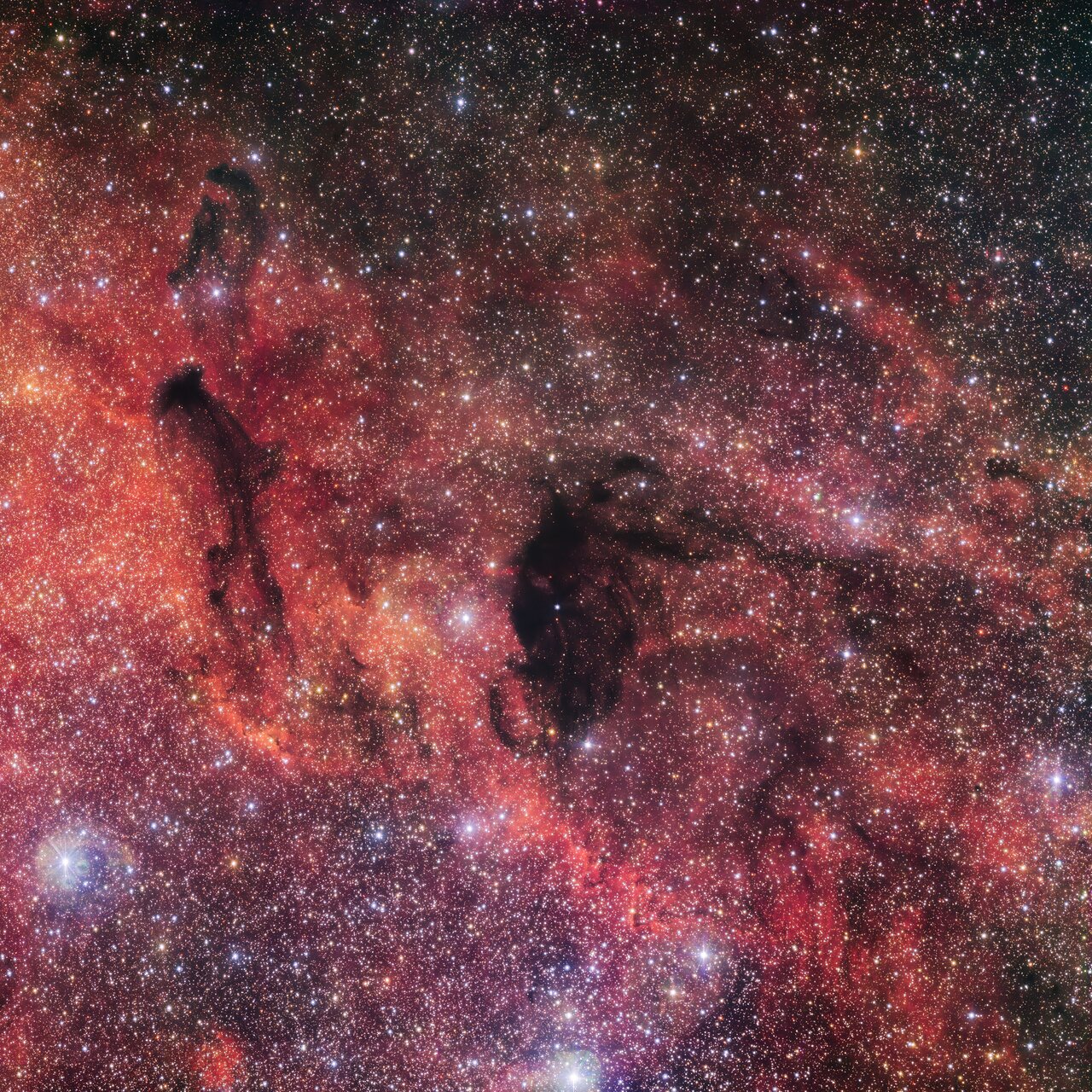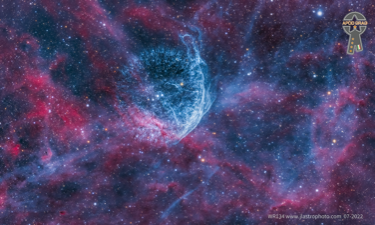Blog
The dark clouds in this image, taken from ESO’s Paranal Observatory in Chile, almost resemble something supernatural, like the wispy trails of ghosts in the sky. But there is no need to call the ghostbusters! These clouds, known as Barnard 92 (right) and Barnard 93 (left) are dark nebulae: they look pitch black because the dense gas and dust they contain block out the background light, creating these hazy ghostlike features. These nebulae are stellar nurseries, where new stars are born out of the collapsing dense gas and dust. This whole region of space imaged here is actually part of a much larger stellar complex, called the Small Sagittarius Star Cloud (or Messier 24, catalogued by Charles Messier in 1764). This area is so rich in stars that it is clearly visible to the naked eye during dark nights, in the constellation of Sagittarius. This image was taken with an enormous 268 million pixel camera called OmegaCAM on the VLT Survey Telescope. OmegaCAM is designed for capturing wide fields like this image, where you could impressively fit four full Moons. This image is part of the VST Photometric Hα Survey of the Southern Galactic Plane and Bulge (VPHAS+), which has mapped diffuse nebulae as well as both young and evolved stars in our galaxy.

Maria Muldaur (born Maria Grazia Rosa Domenica D’Amato; September 12, 1943) is an American folk and blues singer who was part of the American folk music revival in the early 1960s. She recorded the 1973 hit song “Midnight at the Oasis” and continues to record albums in the folk, blues, early jazz, gospel, country, and R&B traditions.
She was the wife of musician Geoff Muldaur and is the mother of singer-songwriter Jenni Muldaur.
Muldaur was born in Greenwich Village, New York City, where she attended Hunter College High School.
Muldaur cites as early musical influences classic country music by Kitty Wells, Hank Williams, Hank Snow, Hank Thompson, Ernest Tubb, and Bob Wills and the Texas Playboys; Alan Freed “rock ‘n’ roll” shows; and doo-wop groups such as The Platters and The Five Satins.
more...
Neil Ellwood Peart OC (/pɪərt/; September 12, 1952 – January 7, 2020) was a Canadian-American musician, songwriter, and author, best known as the drummer and primary lyricist of the rock band Rush. Peart earned numerous awards for his musical performances, including an induction into the Modern Drummer Readers Poll Hall of Fame in 1983, making him the youngest person ever so honoured. Known to fans by the nickname ‘The Professor’, his drumming was renowned for its technical proficiency and his live performances for their exacting nature and stamina.
Peart was born in Hamilton, Ontario, and grew up in Port Dalhousie (now part of St. Catharines). During adolescence, he floated between regional bands in pursuit of a career as a full-time drummer. After a discouraging stint in England, Peart returned home to concentrate on music where he joined Rush, a Torontoband, in mid-1974, six years after its formation. Together they released nineteen studio albums, with ten exceeding a million copies sold in the United States. Billboard ranks the band third for the “most consecutive gold or platinum albums by a rock band”.
Early in his career, Peart’s performance style was deeply rooted in hard rock. He drew most of his inspiration from drummers such as Keith Moon, Ginger Baker, and John Bonham, players who were at the forefront of the British hard rock scene. As time passed, he began to emulate jazz and big band musicians Gene Krupa and Buddy Rich. In 1994, Peart became a friend and pupil of jazz instructor Freddie Gruber.[9][10] It was during this time that Peart revamped his playing style by incorporating jazz and swing components.
In addition to serving as Rush’s primary lyricist, Peart published several memoirs about his travels. His lyrics for Rush addressed universal themes and diverse subjects including science fiction, fantasy, and philosophy, as well as secular, humanitarian, and libertarian themes. Peart wrote a total of seven nonfiction books focused on his travels and personal stories. He also coauthored with Kevin J. Anderson three steampunk fantasy novels based on Rush’s final album, Clockwork Angels. The two also wrote a dark fantasy novella, Drumbeats, inspired by Peart’s travels in Africa.
On December 7, 2015, Peart announced his retirement from touring in an interview with Drumhead Magazine. In January 2018, bandmate Alex Lifesonn confirmed that Rush had disbanded also due to Peart’s health issues. During his last years Peart lived in Santa Monica, California, with his wife, Carrie Nuttall, and daughter. After a three and a half year illness, Peart died of glioblastoma on January 7, 2020, at age 67.
more...“Papa” John DeFrancesco (born September 12, 1940 Philadelphia, PA) is an American jazz organist and vocalist, and father of Joey DeFrancesco and Johnny DeFrancesco.
more...Bill Jennings (September 12, 1919 – November 29, 1978) was an American jazz guitarist and composer.
Recording as both a leader and a sideman, Jennings has been called “the architect of soul jazz” and has influenced on jazz, soul, R&B, and blues guitar. B.B. King often mentioned Jennings as one of biggest influences. Jennings recorded with such artists as Willis “Gator” Jackson, Brother Jack McDuff, Leo Parker, Bill Doggett, Louis Jordan, King Curtis, Louis Armstrong, and Ella Fitzgerald and unique in his ability to play in many styles, including swing, bop, jump blues, R&B, and pop. Jennings played on “Fever” by Little Willie John, which made the Billboard R&B chart in the US and peaked at number 24 on the BillboardHot 100.
A left-handed player, Jennings played guitar upside down, with the high strings at the top, which gave him a different approach to phrasing and bending the strings. Later in his career, he lost a finger on his fretting hand and began playing bass guitar.
more...William Alonzo “Cat” Anderson (September 12, 1916 – April 29, 1981) was an American jazz trumpeter known for his long period as a member of Duke Ellington‘s orchestra and for his wide range, especially his ability to play in the altissimo register.
Born in Greenville, South Carolina, Anderson lost both parents when he was four years old, and was sent to live at the Jenkins Orphanage in Charleston, where he learned to play trumpet. Classmates gave him the nickname “Cat” (which he used all his life) based on his fighting style. He toured and made his first recording with the Carolina Cotton Pickers, a small group based at the orphanage. After leaving the Cotton Pickers, Anderson played with guitarist Hartley Toots, Claude Hopkins‘ big band, Doc Wheeler’s Sunset Orchestra (1938–1942), with whom he also recorded, Lucky Millinder, the Erskine Hawkins Orchestra, Sabby Lewis‘s Orchestra, and Lionel Hampton, with whom he recorded the classic “Flying Home No. 2”.
more...What really happened?
WR 134 is a variable Wolf-Rayet star located around 6,000 light years away from Earth in the constellation of Cygnus, surrounded by a faint bubble nebula blown by the intense radiation and fast wind from the star. It is five times the radius of the sun, but due to a temperature over 63,000 K it is 400,000 times as luminous as the Sun. 
Hiram Law Bullock (September 11, 1955 – July 25, 2008) was an American guitarist known mainly for playing in jazz funk and jazz fusion, but he also worked as a session musician in a variety of genres. Bullock was born in Osaka, Japan, to African American parents serving in the U.S. military. At the age of two he returned to Baltimore, Maryland, with his parents and showed musical talent. He studied piano at the city’s Peabody Conservatory of Music, giving his first public performance at the age of six. After playing saxophone and bass guitar, he took up the electric guitar at age sixteen.
more...Victor Lemonte Wooten (born September 11, 1964) is an American bassist, songwriter, and record producer. He has been the bassist for Béla Fleck and the Flecktonessince the group’s formation in 1988 and a member of the band SMV with two other bassists, Stanley Clarkeand Marcus Miller. From 2017 to 2019 he recorded as the bassist for the metal band Nitro. Born to Dorothy and Elijah Wooten, Victor is the youngest of the five Wooten brothers; Regi, Roy, Rudy, and Joseph Wooten are all musicians. Regi began to teach Victor to play bass when he was two, and by the age of six, he was performing with his brothers in their family band, The Wooten Brothers Band.
As a United States Air Force family, they moved often when Wooten was young. The family settled in Newport News, Virginia in 1972. Wooten graduated from Denbigh High School in 1982. While in high school, he and his brothers played in the country music venue at Busch Gardens theme park in Williamsburg, Virginia. In 1987, he traveled to Nashville, Tennessee, to visit friends that he made at the theme park. One of them was a studio engineer who introduced him to Béla Fleck, with whom he has often collaborated.
more...Leo Kottke (born September 11, 1945) is an acoustic guitarist. He is known for a fingerpicking style that draws on blues, jazz, and folk music, and for syncopated, polyphonicmelodies. He overcame a series of personal obstacles, including partial loss of hearing and a nearly career-ending bout with tendon damage in his right hand, to emerge as a widely recognized master of his instrument. He resides in the Minneapolis area with his family.
more...Mickey Hart (born Michael Steven Hartman, September 11, 1943) is an American percussionist. He is best known as one of the two drummers of the rock band Grateful Dead. He was a member of the Grateful Dead from September 1967 until February 1971, and again from October 1974 until their final show in July 1995. He and fellow Dead drummer Bill Kreutzmann earned the nickname “the rhythm devils”. Michael Steven Hartman was born in Flatbush neighborhood of Brooklyn, New York. He was raised in suburban Inwood, New York by his mother, Leah, a drummer, gown maker and bookkeeper. His father Lenny Hart, a champion rudimental drummer, had abandoned his family when the younger Hart was a toddler. Although Hart (who was hyperactive and not academically inclined) became interested in percussion as a grade school student, his interest intensified after seeing his father’s picture in a newsreel documenting the 1939 World’s Fair. Shortly thereafter, he discovered a practice pad and a pair of snakewood sticks that belonged to his father. “From the age of ten,” he recalled, “all I did was drum.”
more...Roosevelt “Baby Face” Willette(September 11, 1933 – April 1, 1971) was an American hard bop and soul-jazz musician who played the Hammond organ. He was born Roosevelt James Willett (no “e”), in Little Rock, Arkansas, in 1933 according to researchers Bob Eagle and Eric LeBlanc,[1] though other sources state 1934 or 1937. According to the liner notes on his first Blue Notealbum, Grant’s First Stand, Willette was born in New Orleans.
more...NGC 891 (also known as Caldwell 23, the Silver Sliver Galaxy, and the Outer Limits Galaxy) is an edge-on unbarred spiral galaxy about 30 million light-yearsaway in the constellation Andromeda. It was discovered by William Herschel on October 6, 1784. The galaxy is a member of the NGC 1023 group of galaxies in the Local Supercluster. It has an H II nucleus.
The object is visible in small to moderate size telescopes as a faint elongated smear of light with a dust lane visible in larger apertures.
In 1999, the Hubble Space Telescope imaged NGC 891 in infrared.
In 2005, due to its attractiveness and scientific interest, NGC 891 was selected to be the first light image of the Large Binocular Telescope. In 2012, it was again used as a first light image of the Lowell Discovery Telescope with the Large Monolithic Imager.
Supernova SN 1986J was discovered on August 21, 1986 at apparent magnitude 14.

José Monserrate Feliciano García (born September 10, 1945), better known as José Feliciano (Spanish pronunciation: [xoˈse feliˈsjano]), is a Puerto Rican musician, singer and composer. He has had many international hits, including his rendition of the Doors‘ “Light My Fire” and the Christmas single “Feliz Navidad“. His music fuses styles — Latin, jazz, blues, soul and rock—created primarily with his signature acoustic guitar sound.
In the United States, Feliciano became popular in the 1960s, particularly after his 1968 album Feliciano! reached number two on the music charts. Thus far, he has released over fifty albums, worldwide, in both English and Spanish.
José Monserrate Feliciano Garcia was born on September 10, 1945, in Lares, Puerto Rico, the fourth child of 11 sons. He was born blind as a result of congenital glaucoma. He was first exposed to music at the age of 3, playing on a cracker tin can while accompanying his uncle who played the cuatro. When Feliciano was five, his family moved to Spanish Harlem, New York City, where he made his first public appearance at the Teatro Puerto Rico in The Bronx.
more...
William B. Lawsha, better known as Prince Lasha (/ləˈʃeɪ/), (September 10, 1929 – December 12, 2008) was an American jazz alto saxophonist, baritone saxophonist, flautist, clarinetist and English horn player.
Lasha moved to California during the 1950s. In the 1960s, he was active in the burgeoning free jazz movement, of which his Fort Worth cohort Ornette Coleman was a pioneer. Lasha recorded with Eric Dolphy (Iron Man and Conversations, both in 1963) and the Elvin Jones/Jimmy Garrison Sextet featuring McCoy Tyner (Illumination!, also in 1963).
Lasha moved to Europe and in 1966 was based in Kensington, London, The album Insight (1966) by the Prince Lasha Ensemble was recorded in England and featured local musicians, including Bruce Cale, Dave Willis, Jeff Clyne, Rick Laird, Joe Oliver (drums), David Snell (harp), Mike Carr, Stan Tracey, John Mumford (trombone) and Chris Bateson (trumpet).
more...More Posts
- Surviving the Apocalypse 2025 III
- David Crosby Memorial
- Cosmo NGC 1850
- Dolly Parton
- Robert Palmer
- Janis Joplin
- Willie Big Eyes
- Horace Parlan
- World Music Barmer Boys
- Daily Roots The Observers
- All Lives Matter and Black Lives Must Be Free
- MLK Oppression
- Johnny Bragg
- Cosmo NGC 4631/27
- David Ruffin
- Steve Grossman
- Al Foster
- World Music África Negra
- Daily Roots Scientist
- Einstein Do Nothing